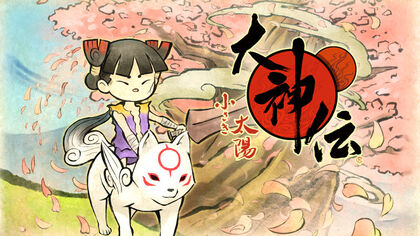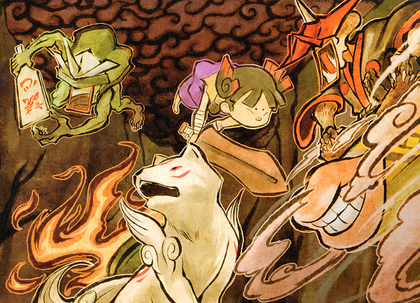mNo edit summary Tag: sourceedit |
Tag: sourceedit |
||
| Line 84: | Line 84: | ||
Image:ODBoxArt.png|''U.S.'' |
Image:ODBoxArt.png|''U.S.'' |
||
Image:ODEurope.png|''Europe'' |
Image:ODEurope.png|''Europe'' |
||
| − | Image:ODOST.png|''OST'' |
+ | Image:ODOST.png|Okamiden ~Chiisaki Taiyou~ ''OST'' |
</gallery> |
</gallery> |
||
Revision as of 17:07, 23 September 2016
Ōkamiden (Ōkamiden: Chiisaki Taiyō (大神伝~小さき太陽~,? lit. Ōkami Chronicles: Tiny Sun in Japan) is an action-adventure game published by Capcom for the Nintendo DS.
It is a direct sequel to the PlayStation 2 and Wii title Ōkami. It was designed by Kuniomi Matsushita, the director of the Wii port of Ōkami, and Motohide Eshiro, producer of Ace Attorney Investigations: Miles Edgeworth and Onimusha 2: Samurai's Destiny.

Okamiden Captivate 2010 Gameplay Trailer
Gameplay Trailer
It was released in Japan on September 30, 2010, and with North American and European releases on March 15, 2011. A Collector's Edition of the game was released in Japan alongside the normal game; in addition to the game, this version included a soundtrack, DVD, storybook, a plush Chibiterasu keychain, and Ōkamiden-marked earphones. Art was done by M. Endo.
Characters

Chibiterasu and Kuni.
- Kuni - the adopted son of Susano and Kushi.
- Kurow - a musician who aids Chibiterasu with his magical flute.
- Kagu - a child actress who becomes one of Chibiterasu's partners on his journey.
- Nanami - mermaid partner who is able to swim for treasure chests.
- Manpuku - one of Chibiterasu's partners, aiding him with the power of fire.
- Master Anura - boss in the form of a giant red toad.
- Bullhead - catfish boss responsible for the flooding of Agata Forest.
- Renjishi - giant mechanical doll boss encountered at the Playhouse.
- Witch Queen - pipe-smoking boss of the Demon Market.
- Mizuchi
- Akuro - is the main antagonist of the game. He is a spirit of pure darkness who aims to find a vessel of light and become powerful enough to shroud the world in darkness. It is revealed that Yami split into five pieces upon his defeat, Akuro being the most powerful of them all.
Returning characters
Story
The game takes place three months after the events of Ōkami. In spite of Amaterasu's battle against the Dark Lord Yami, which would kill all the demons in Nippon, they return. The Konohana Sprite Sakuya, a character from the original Ōkami, summons the Sun Goddess Amaterasu, but instead finds Chibiterasu, who looks like a younger version of Amaterasu. Chibiterasu, as revealed by Matsushira, is, in fact, Amaterasu's child, as was previously speculated. Producer Eshiro noted that he is a "young form of existence" and not fully grown; he retains several abilities of Amaterasu, including the Celestial Brush, but lacks her power, which is reflected in the plot and gameplay.
Chibiterasu's partners are incorporated into the main plot as well. One of the partners that accompanies Chibiterasu is Kuni, the son of Susano and Kushi, two characters from Ōkami. He was born after the events of Ōkami, and appeared in the ending of the first game. They did not reveal how Susano had a son in such a short amount of time, but stated that they would reveal it eventually. Other characters from Ōkami return, including Issun and Mr. and Mrs. Orange. The game features locales from Ōkami, as well as new areas to explore as part of its adventure.
Development
Development began when Kuniomi Matsushita expressed an interest in creating a new Ōkami game, and showed Eshiro a technical demo of such a game in December 2008. Because the demo was so well-done, development began on a sequel. The Nintendo DS was chosen, due to it being the most successful platform of it's generation at the time, its portability which allowed players to pick it up and play wherever they wish as well as the touch screen being ideal for controlling the Celestial Brush. Eshiro stated that; "The staff involved with this game has a real clear understanding of what was fun about the original Ōkami. They have a good understanding of what was important about the visual style and what aspects they need when making this new version so it will transfer well. The work Clover did was amazing; they were really talented people, and I think our staff now is motivated to make a game that lives up to the reputation of the previous Ōkami."[1]
Due to poor sales, Ōkami was considered a commercial failure on the PlayStation 2, and while it was widely believed to be one of the factors involved in the closure of its developer Clover Studio, Hideki Kamiya, lead designer of Ōkami, specified that producer Atsushi Inaba had an argument with Capcom management.[2] Kamiya commented that he had an idea in mind for the sequel and would enjoy making it, but it was nothing more than an idea and beyond his control. Capcom employee Christian Svensson commented that a lot more people would have to buy copies of Ōkami to warrant a sequel to be produced.[3]
In August 2009, Capcom filed for a Japanese trademark on the name "Ōkamiden" for a video game, a few months prior to the Japan release of the Wii version of Ōkami,[4] which led to speculation about an Ōkami sequel; Ōkamiden may be a shortening or pun for Ōkami Gaiden, translated as "Ōkami Sidestory", or possibly Ōkami Densetsu, which translates to "Ōkami Legend", thus fueling speculation that this was be the long awaited sequel. The September 2009 issue of Famitsu revealed that Ōkamiden: Chiisaki Taiyō was indeed another Ōkami game which would be released by Capcom on the Nintendo DS in 2010 in Japan, though no other release information was provided. The Famitsu articles showed gameplay, including combat, and graphics similar to the PlayStation 2 and Wii game.
Ōkamiden is directed by Kuniomi Matsushita, who was responsible for the Wii port of Ōkami, and produced by Motohide Eshiro, who has previously worked on titles such as Onimusha 2: Samurai's Destiny and Ace Attorney Investigations: Miles Edgeworth. Yukinori Kitajima, writer for the critically-acclaimed Japanese Wii title, 428: Fūsa Sareta Shibuya de, was the scenario author for Ōkamiden.[5]
Eshiro further commented that he considered Ōkamiden more of a successor to Ōkami than a sequel, desiring to build upon the world for a franchise on the Nintendo DS platform. While Ōkamiden is a DS title, Eshiro has considered to expand subsequent games to work with the Nintendo 3DS unit based on the game's reception.[6] Similarly, Eshire does not rule out a high-definition version on a modern console or a version for the iPhone or similar touch-screen devices[7] depending on the response to Ōkamiden.
The game was originally going to feature Amaterasu, the protagonist goddess-wolf character from Ōkami; during character planning, one of the artists drew what Amaterasu's child would look like as a joke, but this spurred several ideas for Matsushita, such as the concept of a partner, and leading to Chibiterasu becoming the main character.[8] As Chibiterasu was still a child, the team thought "it would take more than a child to save the world", according to Matsushita, and led to the inclusion of partners both in the game's story and gameplay.[9] This option was selected over several arrangements of characters, such as having five different Chibiterasu's team up as a party. Using a story taken from a child's point of view as they explore and learn new things made the game much easier to visualize, according to Eshiro; he compared this to the movie Stand by Me.
Eshiro also felt it was important to include making friends and having to say goodbye as part of this adventure, striking a strong emotional aspect to the game. As such, Chibiterasu is only paired with one partner at any one time, as Matsushita stated; "if you could switch between them any time you wanted, then they wouldn't be partners anymore". There will be the death of one of the major characters in the game, which Matsushita found necessary to improve the story's flow; the developers had looked to Ōkami and noted while characters also died there, they did not have any emotional attachment for the player, and there was resistance in the development team to have a major character die in Ōkamiden, but it was ultimately decided to do this for the betterment of the story.
The game's story takes place nine months after the events of Ōkami, which posed story problems for Yukinori Kitajima, the game's main script writer. The team originally thought to take the game several years in the future, but found by keeping a closer time frame, things would not change as much from the previous game, giving a familiar feeling to those that played Ōkami. Kitajima had to create rationales for some events, such as the reason why none of the characters remember the end of Ōkami, or why Susano's son Kuni is a young boy when, during Ōkami, he didn't even exist.
Ōkamiden was first shown in playable form at the Tokyo Game Show in September 2009 where it was reported to be about 25% completed.[10] Release in Western markets was uncertain until it was observed that Capcom had trademarked the name Okamiden in both North America and European markets.[11] In April 2010, at its "Captivate" event, Capcom confirmed the game would be released to North American and European markets no later than 2011.[12]
Gameplay
The game plays similarly to its predecessor, Ōkami. It retains the ability to freeze the gameplay and use the Celestial Brush to solve puzzles and fight enemies. The theme of bringing life back to the world also returns from Ōkami. A new feature is the ability for Chibiterasu to team up with partners. They can be used to explore the overworld with, as well as battle enemies. The new Guidance technique may be used to move Chibiterasu's partner independently across areas he cannot cross; this is often required to progress in the game.
The game uses the face buttons to move Chibiterasu about the world, with the top display being the current third-person view and the bottom showing a mini-map of the area. By pressing either shoulder button, the Celestial Brush is activated: the game pauses, as the top screen is moved down to the bottom and rendered as a parchment, and the player then can use the stylus and touchscreen to draw to activate various powers of the Celestial Brush. The game will sense the speed at which the player draws the stylus across the screen, and reflect this in the weight of the stroke drawn on-screen; a quick motion will lead to a faint, partial line while slow movements will create bold strokes.
Reception
Ōkamiden received a great deal of praise, positive reviews and awards from news outlets. However, there have been some criticism on the game. One common criticism that was arguably a problem in the first game is the fact that the game isn't very challenging. The value of the sequel compared to its prequel is debatable however; other reviewers such as thought that Ōkamiden lived up to the series' expectations.
There has also been skepticism about developing Ōkamiden without Platinum Games, a developer featuring key members of Clover Studio, including Hideki Kamiya, the developer behind Ōkami.
Trivia
- Several characters appear in the Japan-only social game Onimusha Soul.
Box Art and Merchandise
References
- ↑ http://www.shacknews.com/onearticle.x/63414
- ↑ http://kotaku.com/gaming/gossip/okami-creator-itching-for-sequel-282133.php
- ↑ http://kotaku.com/5029781/no-okami-2-until-you-buy-more-of-okami-1-ok
- ↑ http://multiplayerblog.mtv.com/2009/08/25/okami-2-rumored-mysterious-trademark-discovered/
- ↑ http://synthese.jp/eng/
- ↑ http://ds.nintendolife.com/news/2010/06/e3_2010_interviews_okamiden_capcom
- ↑ http://www.eurogamer.net/articles/2010-09-30-iphone-ipad-okamiden-planned
- ↑ http://www.siliconera.com/2010/04/22/originally-amaterasu-was-the-main-character-of-okamiden/
- ↑ http://www.1up.com/news/okamiden-story
- ↑ http://www.siliconera.com/2009/09/02/okamiden-is-a-sequel-after-all/
- ↑ http://www.escapistmagazine.com/news/view/98467-Okamiden-Trademarked-in-North-America-Europe
- ↑ http://www.shacknews.com/onearticle.x/63389






